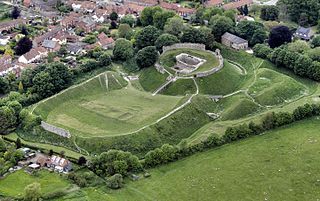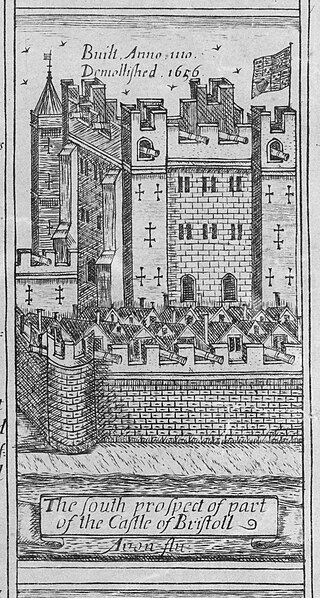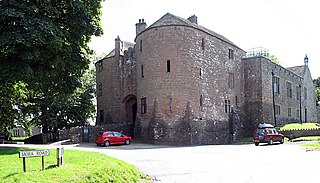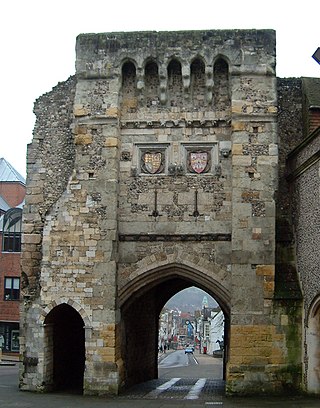
The remains of Ashley Castle are in the small village of Ashley, Test Valley, in Hampshire (grid reference SU385308 ). The visible remains now consist of sections of the ditch and ramparts.

The remains of Ashley Castle are in the small village of Ashley, Test Valley, in Hampshire (grid reference SU385308 ). The visible remains now consist of sections of the ditch and ramparts.
The castle (also sometimes referred to as Gains Castle), was originally built in 1138, on the site of a former Iron Age fort. The site is likely to have been of strategic value, having a well, standing on high ground above the Somborne valley, and lying a short distance from the Roman road from Winchester to Sarum. Its builder was the powerful Henry de Blois, a grandson of William I of England, and the younger brother of King Stephen. Henry de Blois was the Bishop of Winchester from 1129 until his death 1171, a prolific builder (including of Wolvesey Castle, the bishop's palace in Winchester, and of a number of castles), and one of the most powerful figures of his day in the English kingdom.
The castle was built during the Anarchy, a prolonged period of unrest and civil war between opposing factions led by King Stephen and the Empress Matilda. The Anarchy ended with the consensual accession of Matilda's son Henry II in 1154. Shortly afterwards, in 1155, Ashley Castle was slighted (partially demolished), along with other castles built by Henry of Blois. [1] Although Henry II was the son of the Empress Matilda, and Henry of Blois was the brother of her adversary, King Stephen, this was not necessarily an act of retaliation against Henry of Blois; in re-asserting royal authority through the realm, Henry II destroyed numerous unauthorised castles that had been raised during the Anarchy. Further, Henry of Blois had been directly involved in negotiating the peace settlement which ended the Anarchy. [2]
Despite its slighting in the 1150's, Ashley castle was to have a second lease of life. Within fifty years, during the reign of Henry II's son King John, Ashley Castle was restored by a new owner, William Briwere the elder (c.1145-1226), probably in stone. William Briwere was a wealthy landowner who held the manor of Ashley, [3] as well as large estates in the west country. He was a powerful man and a leading counsellor of three successive kings of England, King Richard I of England, King John and King Henry III. In an early account Briwere was referred to as one of King John's "evil advisers". [4] Intriguingly for aficionados of Robin Hood, one of the offices he held, from 1194 to 1199, was High Sheriff of Nottinghamshire, Derbyshire and the Royal Forests, which makes him a theoretical model for the fictitious Sheriff of Nottingham in the Robin Hood legend. He is also said to have been involved in the signing of Magna Carta in 1215 (though perhaps reluctantly, given his allegiance to the King), [5] founded Mottisfont Abbey, a house of Augustinian canons six miles from Ashley (to whom he donated St Mary's Church, Ashley [3] ), and ended his days in 1226 as a Cistercian monk at Dunkeswell Abbey in Devon.
In 1200 King John granted Briwere a licence to crenellate a number of castles, including, in Hampshire, one at either Stockbridge or Ashley, at Briwere's election. [6] Briwere chose Ashley (referred to in the grant as "Esleg"). (There is no castle in Stockbridge, so the reference to it in the grant is a mystery; it may conceivably have been to the ancient hill fort above that town at Woolbury). In an age when the crown saw a potential rebel stronghold in every castle held by a nobleman, and the Anarchy was a recent memory, permission to fortify in this way was a rare privilege. Only five known licences to crenellate were granted in 1200, three of them to John Briwere. [7]
King John is documented as having stayed frequently at Ashley, possibly in connection with hunting expeditions in the royal forest of West Bere (also known as Bere Ashley), part of the Forest of Bere, which stretched from the River Itchen to the River Test (which lies two miles west of Ashley). [3] [8] Ashley was the administrative headquarters of the royal forest of West Bere. Official crown business is known to have been transacted from the castle, as a number of royal letters from this era are headed 'Ashley'. The chief royal officer for the forest (which included villages) was the Warden, who had responsibility for enforcing forest law. Wardens were generally important magnates, as Briwere was. The Warden of West Bere had his manor at Ashley, and would have stayed in Ashley castle when in residence. Many royal forests in England had a castle headquarters of this sort. In addition to serving as a residence, pleas were heard, poachers sometimes imprisoned and forest officers housed there. Despite its role as an administrative base for crown land, Ashley Castle appears always to have been considered as part of the manor of Ashley rather than as crown property, and the interests of the wardens were often allowed to overrule the interest of the sovereigns whose property they were supposed to be protecting. [9]
The manor of Ashley passed in 1312 from the Briweres to the Despensers, [3] a family in league with another unsuccessful and unpopular king, Edward II of England. Hugh Despenser the Younger was an infamous favourite and counsellor of King Edward II of England, after whose overthrow in 1326 he was found guilty of high treason and hanged, drawn and quartered. Despite this fall from grace, Ashley was shortly afterwards restored to the Despensers, only for history to repeat itself in 1400 when Thomas Despenser, 1st Earl of Gloucester, a supporter of another unpopular King, Richard II of England, was beheaded for his part in the Epiphany Rising against King Henry IV of England. Ashley Castle itself became a residence of the Bishops of Winchester until the middle of the 15th century. It was eventually abandoned as a residence in about the 17th century. [10] All retrievable stone was removed and re-used elsewhere.
In its earliest form, the castle was an earth and timber ringwork fortification. The ringwork was located on a spur of high ground and consisted of a banked rampart surrounded by a deep ditch, probably re-using the earlier Iron Age defences. A Great Hall and/or tower stood within the ringwork. Extending westwards in a loop from the ringwork was a second, outer bank enclosing a broadly rectangular court - the bailey - which contained all the ancillary domestic buildings associated with such a settlement. Both banks were surmounted by wooden palisades. [9] Also located in the bailey was the parish church, St Mary's Church, Ashley, which probably dates from the same period as the original castle (early 12th century). The church survives, long outliving the castle. The visible remains of the castle now consist of sections of the ditch and ramparts.
The castle is typically Norman in the small size of the occupied area and the strength of its ramparts, and in having a bailey; its north-east part contains visible remains of foundations. [11] [12]
The site, on private land, is a scheduled monument, protected by law. [13]

Stephen, often referred to as Stephen of Blois, was King of England from 22 December 1135 to his death in 1154. He was Count of Boulogne jure uxoris from 1125 until 1147 and Duke of Normandy from 1135 until 1144. His reign was marked by the Anarchy, a civil war with his cousin and rival, the Empress Matilda, whose son, Henry II, succeeded Stephen as the first of the Angevin kings of England.

Geoffrey V, called the Handsome, the Fair or Plantagenet, was the Count of Anjou, Touraine and Maine by inheritance from 1129, and also Duke of Normandy by his marriage claim, and conquest, from 1144.

The Anarchy was a civil war in England and Normandy between 1138 and 1153, which resulted in a widespread breakdown in law and order. The conflict was a war of succession precipitated by the accidental death of William Adelin who drowned in the White Ship disaster of 1120. Henry sought to be succeeded by his daughter, known as Empress Matilda, but was only partially successful in convincing the nobility to support her. On Henry's death in 1135, his nephew Stephen of Blois seized the throne, with the help of Stephen's brother Henry of Blois, who was the bishop of Winchester. Stephen's early reign saw fierce fighting with disloyal English barons, rebellious Welsh leaders, and Scottish invaders. Following a major rebellion in the south-west of England, Matilda invaded in 1139 with the help of her half-brother Robert of Gloucester.

Robert FitzRoy, 1st Earl of Gloucester was an illegitimate son of King Henry I of England. He was the half-brother of the Empress Matilda, and her chief military supporter during the civil war known as the Anarchy, in which she vied with Stephen of Blois for the throne of England.

Henry of Blois, often known as Henry of Winchester, was Abbot of Glastonbury Abbey from 1126, and Bishop of Winchester from 1129 to his death.
Matilda was Countess of Boulogne in her own right from 1125 and Queen of England from the accession of her husband, Stephen, in 1135 until her death in 1152. She supported Stephen in his struggle for the English throne against their mutual cousin Empress Matilda. She played an unusually active role for a woman of the period when her husband was captured, and proved herself an effective general who managed to force the Empress to release Stephen. Under the agreement that settled the civil war, the Queen's children did not inherit the English throne; however, her three surviving children ruled Boulogne in turn as Eustace IV, William I, and Marie I.

Crondall is a village and large civil parish in the north east of Hampshire in England, in the Crondall Hundred surveyed in the Domesday Book of 1086. The village is on the gentle slopes of the low western end of the North Downs range, and has the remains of a Roman villa. Despite the English Reformation, Winchester Cathedral held the chief manors representing much of its land from 975 until 1861. A large collection of Anglo-Saxon and Merovingian coins found in the parish has become known as the Crondall Hoard.

Wolvesey Castle, in Winchester, Hampshire, England, has been the main residence of the Bishop of Winchester since the Middle Ages. The residence, mostly built by Henry of Blois, is now a ruin, except for its chapel, but the bishop continues to live in the later Wolvesey Palace. It was never actually a castle, though Henry had it fortified after the power struggle between his brother King Stephen and the Empress Matilda.

Winchester Castle is a medieval building in Winchester, Hampshire, England. It was founded in 1067. Only the Great Hall still stands; it houses a museum of the history of Winchester.

The Treaty of Wallingford, also known as the Treaty of Winchester or the Treaty of Westminster, was an agreement reached in England in the summer of 1153. It effectively ended a civil war known as the Anarchy (1135–54), caused by a dispute over the English crown between King Stephen and his cousin Matilda. The Treaty of Wallingford allowed Stephen to keep the throne until his death, but ensured that he would be succeeded by Matilda's son Henry II.

Castle Acre Castle and town walls are a set of ruined medieval defences built in the village of Castle Acre, Norfolk. The castle was built soon after the Norman Conquest by William de Warenne, the Earl of Surrey, at the intersection of the River Nar and the Peddars Way. William constructed a motte-and-bailey castle during the 1070s, protected by large earthwork ramparts, with a large country house in the centre of the motte. Soon after, a small community of Cluniac monks were given the castle's chapel in the outer bailey; under William, the second earl, the order was given land and estates to establish Castle Acre Priory alongside the castle. A deer park was created nearby for hunting.

Bristol Castle was a Norman castle built for the defence of Bristol. Remains can be seen today in Castle Park near the Broadmead Shopping Centre, including the sally port. Built during the reign of William the Conqueror, and later owned by Robert FitzHamon, it became an important royal castle and was the scene of several imprisonments and executions. The castle was modified and further fortified between the 12th and 13th centuries under Robert of Gloucester and King Henry III. By the 16th century it was mostly neglected; it was torn down in 1656 under orders from Oliver Cromwell.

St Briavels Castle is a moated Norman castle at St Briavels in the English county of Gloucestershire. The castle is noted for its huge Edwardian gatehouse that guards the entrance.
William FitzEmpress or William Longespee was the youngest of the three sons of Empress Matilda and Geoffrey Plantagenet, Count of Anjou. His brothers were Henry II of England and Geoffrey, Count of Nantes.

In the Rout of Winchester the army of imprisoned King Stephen of England, led by his wife, Queen Matilda of Boulogne, Stephen's brother Bishop Henry of Blois, and William of Ypres, faced the army of Stephen's cousin Empress Matilda, whose forces were commanded by her half-brother Earl Robert of Gloucester. After Empress Matilda's army besieged a castle on the edge of Winchester, Queen Matilda's army arrived and blockaded the Angevin army within the city. Cut off from supplies, the Angevin army gave up the siege, then was crushed as it began to retreat. Robert of Gloucester was captured and was subsequently exchanged for Stephen, who was returned to the throne of England. However, the civil war known as The Anarchy dragged on with neither side gaining an advantage.
Events from the 1150s in England.
Events from the 1130s in England.

William de Chesney was an Anglo-Norman magnate during the reign of King Stephen of England and King Henry II of England. Chesney was part of a large family; one of his brothers became Bishop of Lincoln and another Abbot of Evesham Abbey. Stephen may have named him Sheriff of Oxfordshire. Besides his administrative offices, Chesney controlled a number of royal castles, and served Stephen during some of the king's English military campaigns. Chesney's heir was his niece, Matilda, who married Henry fitzGerold.
Isabella de Beauchamp, Lady Kidwelly, Baroness Despenser, was an English noblewoman and wealthy heiress.

The feudal barony of Plympton was a large feudal barony in the county of Devon, England, whose caput was Plympton Castle and manor, Plympton. It was one of eight feudal baronies in Devonshire which existed during the medieval era. It included the so-called Honour of Christchurch in Hampshire, which was not however technically a barony. The de Redvers family, first holders of the barony, were also Lords of the Isle of Wight, which lordship was not inherited by the Courtenays, as was the barony of Plympton, as it had been sold to the king by the last in the line Isabel de Redvers, 8th Countess of Devon (1237–1293).